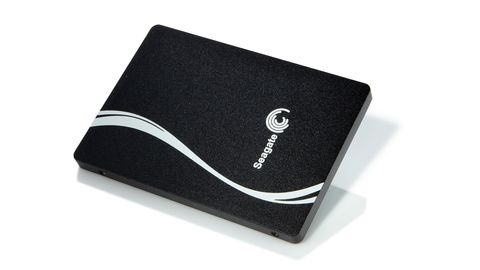TechRadar Verdict
Pros
- +
Good speeds
- +
Decent price (although Crucial drive is cheaper)
Cons
- -
Bad timing with Crucial's latest drives undercutting these
Why you can trust TechRadar
You might think Seagate's only venture into the murky world of SSDs came with its Momentus XT SSHD (solid state hybrid drive).
The storage company has been plugging away with this hybrid experiment for quite a while with varying degrees of success, and while the lack of pure-blood SSDs is true for the consumer market segment, it's a different story in the enterprise segment - Seagate has been producing pure SSDs for a long time.
Now it has taken the plunge and launched the 600 series of pure solid state drives for the bloodletting arena that is the consumer SSD market space. The 600 series is currently available in three capacities: 120GB, 240GB and the flagship 480GB model we're looking at here.
Opening the drive reveals that everything is built on one side of the PCB. At one end of the board sit the eight NAND chips that make up the drive's capacity. These are the latest Type C 19nm Toggle MLC 64GB chips from Toshiba. At the other end of the board is the LM87800AA controller, and underneath that you'll find the cache in the shape of two 256MB DDR2 memory chips.
For the 600 series, Seagate has used a Link-A-Media (LAMD - now SK Hynix) LM87800AA eight-channel controller to take care of things. This isn't a new controller - Corsair used it for its Neutron and Neutron GTX range of drives - but more to the point it's the controller Seagate uses in its Pulsar.2 enterprise drives. In fact Seagate was also involved with LAMD in the silicon's original development.
Benchmarks
Sequential read performance
AS SSD: Megabytes per second (Bigger is better)
Seagate 600 480GB: 513
Crucial M500 480GB: 488
Kingspec Challenger E3000: 480
Sequential write performance
AS SSD: Megabytes per second (Bigger is better)
Seagate 600 480GB: 437
Crucial M500 480GB: 408
Kingspec Challenger E3000: 325
4K random write performance
AS SSD: Megabytes per second (Bigger is better)
Seagate 600 480GB: 14.8
Crucial M500 480GB: 22.5
Kingspec Challenger E3000: 22.4
Performance-wise, Seagate quotes up to 500MB/s for the sequential reads across the range, and up to 400MB/s for sequential writes for the 480 and 240GB models. The 120GB model's write performance drops to 300MB/s, though.
These figures are pretty much consistent with the ATTO benchmark: 506MB/s for the reads, with a slightly better than quoted 448MB/s write performance. Looking at the AS SSD benchmark, it's a similar story: 513MB/s reads and 437MB/s writes for the headline sequential performance.
The controller doesn't seem to care what type of data is being passed to it either; switching to the compressed data test in AS SSD gives up a sequential read speed of 512MB/s, and a write speed of 446MB/s.
Verdict
It's good to finally see another major player in the storage sector enter the bear pit that is the consumer SSD market - and Seagate's 600 series looks pretty damn good from the off.
The only problem is Crucial has launched its M500 series at the same time, and its high-density drives represent a potential line in the sand for the consumer SSD segment. The two largest drives in the Seagate range offer a highly competitive price per gigabyte that consumers could only dream about a year or so ago.
You can't help feeling sorry for Seagate, though. Here it is, offering a new line of drives with some pretty competitive pricing, and Crucial comes along and cuts it (and to be fair everybody else) off at the knees with the impressive M500 series.

